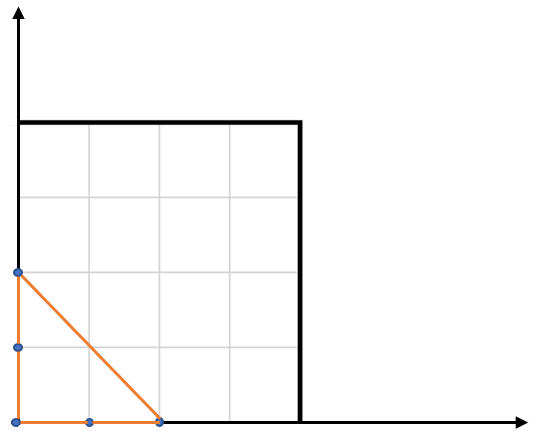Given an array of points on the X-Y plane points where points[i] = [xi, yi], return the area of the largest triangle that can be formed by any three different points. Answers within 10-5 of the actual answer will be accepted.
Example 1:
Input: points = [[0,0],[0,1],[1,0],[0,2],[2,0]] Output: 2.00000 Explanation: The five points are shown in the above figure. The red triangle is the largest.
Example 2:
Input: points = [[1,0],[0,0],[0,1]] Output: 0.50000
Constraints:
3 <= points.length <= 50-50 <= xi, yi <= 50- All the given points are unique.
class Solution:
def largestTriangleArea(self, points: List[List[int]]) -> float:
ans = 0
for x1, y1 in points:
for x2, y2 in points:
for x3, y3 in points:
u1, v1 = x2 - x1, y2 - y1
u2, v2 = x3 - x1, y3 - y1
t = abs(u1 * v2 - u2 * v1) / 2
ans = max(ans, t)
return ansclass Solution {
public double largestTriangleArea(int[][] points) {
double ans = 0;
for (int[] p1 : points) {
int x1 = p1[0], y1 = p1[1];
for (int[] p2 : points) {
int x2 = p2[0], y2 = p2[1];
for (int[] p3 : points) {
int x3 = p3[0], y3 = p3[1];
int u1 = x2 - x1, v1 = y2 - y1;
int u2 = x3 - x1, v2 = y3 - y1;
double t = Math.abs(u1 * v2 - u2 * v1) / 2.0;
ans = Math.max(ans, t);
}
}
}
return ans;
}
}class Solution {
public:
double largestTriangleArea(vector<vector<int>>& points) {
double ans = 0;
for (auto& p1 : points) {
int x1 = p1[0], y1 = p1[1];
for (auto& p2 : points) {
int x2 = p2[0], y2 = p2[1];
for (auto& p3 : points) {
int x3 = p3[0], y3 = p3[1];
int u1 = x2 - x1, v1 = y2 - y1;
int u2 = x3 - x1, v2 = y3 - y1;
double t = abs(u1 * v2 - u2 * v1) / 2.0;
ans = max(ans, t);
}
}
}
return ans;
}
};func largestTriangleArea(points [][]int) float64 {
ans := 0.0
for _, p1 := range points {
x1, y1 := p1[0], p1[1]
for _, p2 := range points {
x2, y2 := p2[0], p2[1]
for _, p3 := range points {
x3, y3 := p3[0], p3[1]
u1, v1 := x2-x1, y2-y1
u2, v2 := x3-x1, y3-y1
t := float64(abs(u1*v2-u2*v1)) / 2.0
ans = math.Max(ans, t)
}
}
}
return ans
}
func abs(x int) int {
if x < 0 {
return -x
}
return x
}
